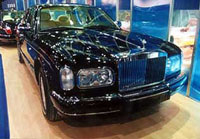
Although China's prices of sedans are among the highest in the world, many are still selling like hot cakes, the Beijing-based China Economic Times reported.
Statistics show that China has been the top consumer of limousine brands such as Rolls-Royce and Bentley, and their sales volume in the whole Asian continent accounts for about 20 percent of the globe total.
According to German figures, China has been the biggest potential market for BMW and Mercedes-Benz in the world, with a combined sales volume between 6,000 to 7,000 units every year.
The newspaper said various famous international car-makers are competing with each other now for more market share in China.
Mercedes-Benz is cooperating with Chinese institutions on car research and plans to establish a design center here.
The three others, outside of Germany, can be found in the United States, Japan and Italy.
Meanwhile, Volkswagen, also from Germany, has set up a new lab center in China's capital of Beijing, the paper said. The founding of these research and design centers indicates that the competition among multinational cars producers in China now includes research in addition to sales.
As a price gap exists between China's and the international auto market, the returns of limousines from the domestic market are much higher than the five-percent profit margin in the international market.
A survey shows that the average domestic prices of Chinese-made limousines are between 37,000 to 61,600 US dollars (300,000 to 500,000 yuan), while the prices of the same types of autos in the U.S. market are between 25,000 to 32,000 US dollars, with a 50-100percent price gap which leads to a huge profit scale, the paper said.
On the other hand, the domestic-made sedans produced by joint venture companies in China, and the continuous cost drop of outdated types without price falls also resulted in huge profits, according to the newspaper.
Over 30 percent of the manufacturers' gain resulted from spare part sales, which have been monopolized by auto makers, the paper added.
Considering the market demand and brand reputation, experts analyzed that the prices of limousines would not decrease by largemargins from 2005 to 2006, according to the newspaper.
Although the tariff for limousines has dropped to 30 percent from 34.2 percent since January 1, 2005 and is expected to decrease to 25 percent by July 1, 2006, the 17-percent value added tax, the consumption tax of between three to eight percent, and other customs and transportation charges will not change, preventing car prices from further slipping, insiders said.
Some noted that major consumers of limousines in China are entrepreneurs, professional managers of foreign companies, professionals with high incomes, young white-collar workers and car aficionados, according to the newspaper.
Some rich people in China consider limousines a symbol of wealth and status without considering their high prices, the newspaper said.
(Xinhua News Agency August 27, 2005)
|

